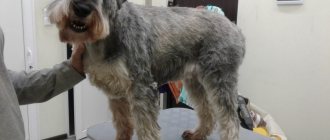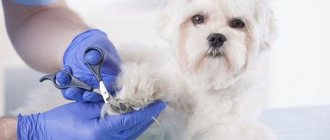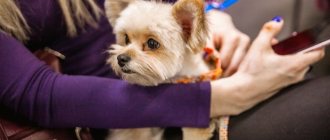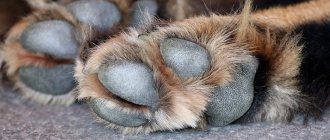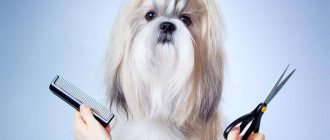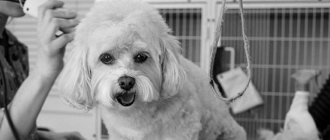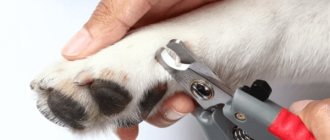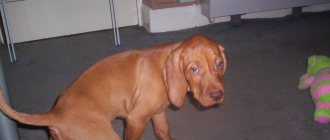Dog trimming (stripping, rolling), or artificial shedding is the manual removal of mature, non-shedding hair from wire-haired pets and dogs with a wiry coat type.
Wire-haired dogs of show class, i.e. those who go to exhibitions are only trimmed by hand, not cut. Variations are possible for pets.
We work with all breeds of dogs that require trimming (terriers, schnauzers, griffons, dachshunds, etc.). Knowledge of trimming techniques, breed standards, experience, careful attitude and individual approach allow us to carry out this procedure efficiently and painlessly for the dog. This is a long, labor-intensive and rather complex process.
Do not confuse this type of grooming with express shedding for self-shedding dogs or cats, more on that below...
It’s very simple to sign up your dog for trimming: > on this page yourself, by selecting the button in the page menu - “pencil”, or by clicking on the yellow round button on the right; >and also by phone
Trimming (stripping) of dogs
Wire-haired breeds of dogs were bred for hunting; the wool protected the animals from thorny plants and moisture, was less dirty, and practically did not smell. But, these dogs do not shed on their own. The wool fell out naturally, clinging to thorns, grass, and the ground in burrows.
Nowadays, for the most part, wire-haired dogs are pets because these bearded dogs with shaggy eyebrows are incredibly cute, their fur does not cause allergies in owners, does not smell and yes, does not shed, and there is less need to clean up after them! But now we, the owners, need to help these beauties get rid of dying hairs - trimming or cutting?...
When trimming, dead hairs are plucked/plucked from their bulb (follicle)
, thereby releasing it and allowing new full-fledged hairs to grow, without cutting it off. We do this with our fingers, and sometimes we use a special knife, stone or pumice.
In dogs with a double coat type, the undercoat is carefully combed out ( "scraping"
or
“carding”
) so that the guard hair fits tightly to the body and the dog does not look disheveled.
Show trimming and trimming for a domestic dog are two very different things.
Exhibition trimming is a complex, step-by-step, regular process, taking into account the breed characteristics of the dog and its constitution.
Salon trimming is easier, but it is advisable to adhere to a certain regularity so that the coat is ready for this procedure and does not “overripe” when trimming already becomes a difficult and painful process for the pet.
Choosing a Groomer
- First, you need to decide where you will strip your pet. At home or in the salon. If you do it at home, you can save money, but there is also the possibility of an unqualified person coming in to do home haircuts for dogs. If you go to a salon, the cost of dog grooming will most likely be more expensive, but the specialist will almost certainly be experienced.
Before choosing a groomer, you need to look at his work. The best option would be if you can watch the hair removal process, and not just the finished work.
- Before going for a haircut, you can ask for advice and feedback from friends and acquaintances. Of course, this is not always a guarantee of good work. Groomers may not be generalists. For example, they may be good at grooming one breed of dog but not another. Listen carefully to all advice and draw your own conclusions.
- A good option is to get contact information from a good groomer from the breeder you bought your dog from. This option is the best, since most likely this master is really good at his job.
- When considering specialist options, analyze not only the quality of hair removal, but also the specialist’s manner of communication with dogs. Animals treat people differently; they feel how they treat themselves. Therefore, if your pet is happy with everything, it means that you have found your groomer.
What dog breeds need trimming?
- Schnauzers (Giant Schnauzer, Miniature Schnauzer, Miniature Schnauzer)
- Griffon (Belgian, Brussels)
- Terriers: Jack Russell Terrier (wire-haired and smooth-haired), Scotch terrier or Scottish, Irish, Fox Terrier (smooth-haired and wire-haired), and Airedale terrier, Welsh, West Highland White, Tibetan, Norfolk Terrier, Norwich Terrier, etc. .)
- Wire-haired dachshund
- Wire-haired mixed breed (nobleman)
- English cocker spaniel
- English Springer Spaniel
- American Cocker Spaniel
In the salon or at home?
Home care is possible, but less safe. Working on your own, you can accidentally injure your dog, pull out new hairs or form bald spots. If you have a desire to learn, entrust the first treatment to a groomer and watch his actions. It is possible to master the technique, but it will take time.
Grooming salons guarantee high-quality results and the safety of four-legged visitors. Some craftsmen work from home. This option is suitable for shy pets. Usually the excitement goes away by the third session.
If you need to prepare before an exhibition, contact a groomer. Any error that affects the breed standard will result in a lower score.
What types of dog trimming are there?
Manual stripping, karting and placking are grooming practices as old as time, requiring special tools, skills, tenacious fingers and healthy joints of the master. As a result of these techniques, the new coat grows back to be coarse, heavy and tight to the skin. Trimming can be carried out on both dirty and clean fur, but for better adhesion it is recommended not to wash the dog and even treat the fur with special talcum powder. When working with your fingers, wear a rubber glove or finger pads.
- Carding
- removal and thinning of soft undercoat. The groomer can use a special pumice stone, stripper, furminator, trimmers or clipper knives. Combing the undercoat can be done either in the direction of hair growth or against it (linear method). After carding, the guard hair will fit tightly to the dog's skin and will not bristle.
- Stripping
- Rolling
- removal by plucking mature guard (decorating) hairs of a dog's fur using a special tool or with the fingers of a dog groomer ( plaiting)
). Stripping is usually carried out during the natural molting period, in spring and autumn, at least 2 times a year. After a properly performed stripping, the dog should not look bald or bald, but the skin may be somewhat irritated and reddened.
- this is a regular, uniform trimming and combing of the dog's mature hair. It is carried out at least once every 1-2 months, mostly monthly. This is the best way to keep your dog beautiful and well-groomed all the time. With this care, the coat becomes multi-layered, it gets dirty less, does not tangle, and the dog always looks 100%.
A haircut.
Some owners of their gestural dogs do not trim them, but cut them with clippers. The owner thinks that trimming is a painful procedure. This is not entirely true. If you trim the dog systematically, it does not hurt at all, because only dead hair is removed, which does not fall out on its own, like in other breeds, but sticks out from the skin, interfering with the growth of new hairs. If you simply cut these hairs, the dog’s fur ceases to be coarse, new hairs grow thin (they lack nutrition and space in the hair follicle), the fur becomes fluffy, and sometimes even begins to curl into curls. In order to subsequently restore the hard, straight structure of the coat, you must begin a difficult and unpleasant procedure - full stripping (bare), and then regularly pluck the dog at least once every 2 months.
Express shedding of shedding dog breeds.
If the dog sheds on its own and annoyingly drops hair all around it; or the dead hair (undercoat) does not fall out, but gets stuck between the new hairs, bunching up in tangles and making the pet untidy, like a Spitz, or a chow-chow, then the groomer, or you yourself must comb the dog regularly to speed up and finish this process faster . The dead hairs of such dogs have already fallen out of their hair follicles on their own, but are stuck halfway. To make these hairs come off better, we use a warm bath for dogs with masks and conditioners, intense air pressure, rubber gloves, and stripping.
Let's see how dog trimming and express shedding goes behind the scenes of a grooming salon?
What is the difference between trimming and express shedding? What does a dog look like after stripping or rolling?
When needed | Can I start trimming the puppy?
Puppies of wire-haired dog breeds should begin trimming from 3 months of age, when the coat begins to curl. This puppy fluff can be easily removed by hand - with the thumb and forefinger wearing rubber fingertips or gloves. Subsequently, new fur will grow under the fluff, which will look neat and will cover the puppy until 7 months of age. When the long hairs that have grown begin to die off, change color and become tangled, the dog is again ready for trimming. The adult coat will be identified after the third or fourth molt. Unfortunately, many owners leave the puppy's fur until he is one year old and only then take him to a pet salon, and then the groomer has a lot more hard work, and the dog has to endure a lot more discomfort.
Attention!
Trimming dogs at Mishka's pet salon is an additional procedure. The condition of the dog's coat is assessed by the master, taking into account regular visits to the salon. With a complex of procedures, the cost of services is added up, but the complex is always cheaper! The grooming and trimming complex includes all the necessary manipulations for the dog: trimming, a full range of hygiene, bathing with a spa, drying and trimming the hairstyle according to the breed. However, parsing or shaving of tangles is not included in the cost of the service; this is carried out for an additional fee - see price list.
Work algorithm
The process begins by preparing the animal's fur. Owners are not recommended to wash their dog the day before. Dirt and dust allow for better grip on the tool.
Masters comb the animals with a slicker brush. Then the tangles are removed and separated manually using oils. Scissors are used in extreme cases, when hairballs cannot be processed.
Trimming takes place in 3 stages:
- First, take the tool and pluck the hair, pressing it between the working surface and the thumb. The choice of device depends on the depth of the procedure and the quality of the coat. The process starts from the back of the animal's head and moves towards the tail.
- With well-honed sharp jerks, the craftsmen pull out the wool in the direction of its growth. This is completely painless for the pet; some of them fall asleep during the lengthy procedure. Treatment of the armpits, muzzle, and thighs, that is, the most sensitive areas of the body, causes slight discomfort.
- The sequence of treatment is as follows: first clean the sides, then the back and then move on to the delicate areas.
No matter how long the trimming lasts, you cannot leave the process for the next few days. It is recommended to take breaks of 15-20 minutes so that the animal calms down and continue working until its logical conclusion.
After finishing plucking, wash your hands thoroughly and treat the used tool.
Gallery Show all
How to choose a webbing cutter
Before using this tool, you need to choose it correctly. The following factors should be taken into account:
- the longer the cat's fur, the larger the teeth should be;
- the handle should be rubberized so that the hair cutter does not fall out of your hands during operation;
- pay attention to the quality of the steel: a cheap hair cutter will quickly become dull and cause pain to the cat.
It’s better to overpay a little, but get a quality tool that will last longer.
If you are purchasing as a gift, choose a horizontal one with medium-length blades. This is a universal device that will suit any cat.
